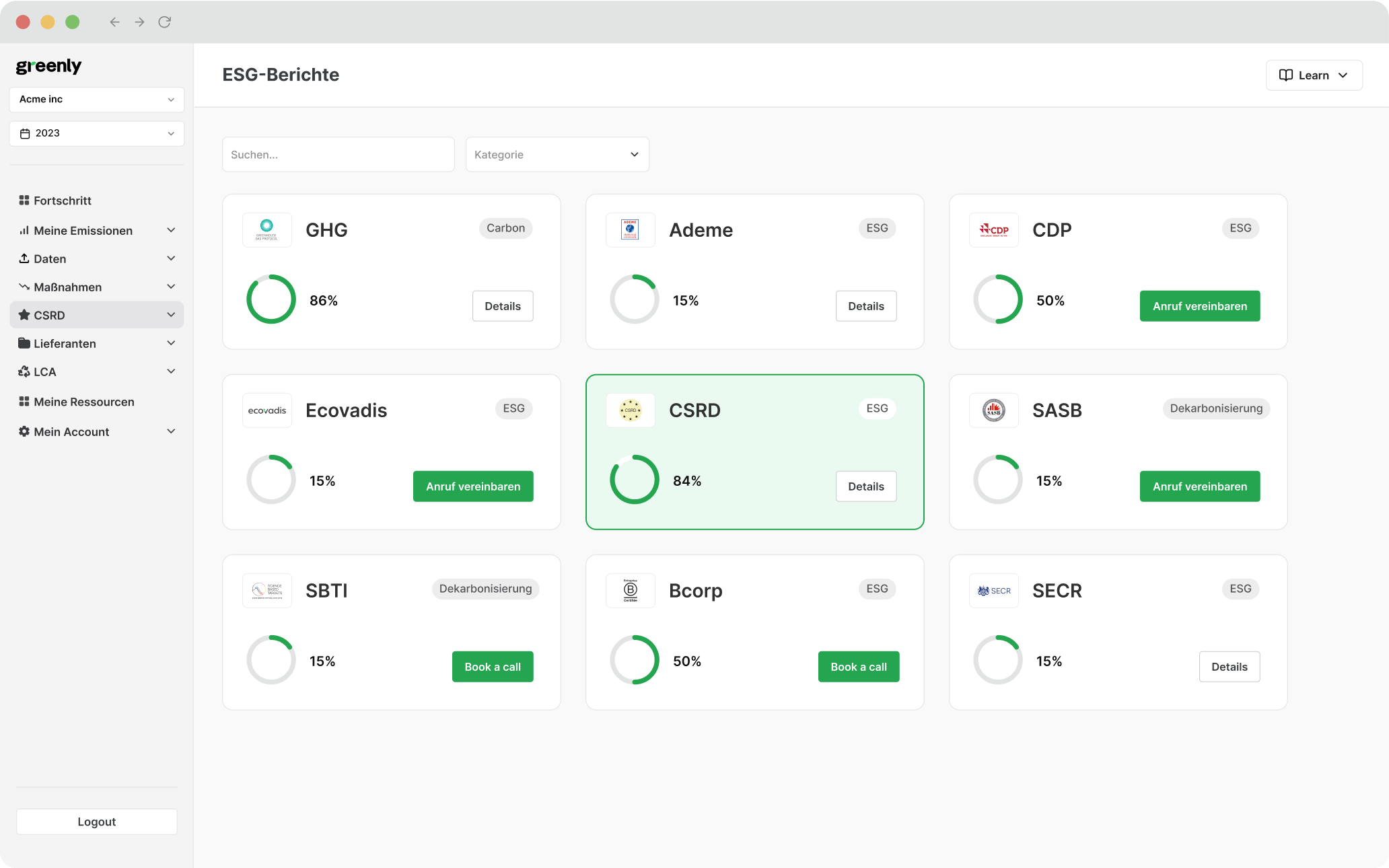
What are the 3 Pillars of Corporate Sustainability?
In this article, we'll explore what the 3 pillars of corporate responsibility are, why they're important, and how businesses can turn them into practical action.
ESG / CSR
Industries



As sustainability reporting becomes more regulated, businesses around the world are under growing pressure to disclose clear, consistent information on their environmental and climate-related risks. In response, the International Financial Reporting Standards Foundation (IFRS) has introduced two global disclosure standards – IFRS S1 and IFRS S2 – setting a new benchmark for sustainability transparency.
But implementing these standards is no easy task. Companies need to collect ESG data across departments, assess climate risks, map disclosures to financial outcomes, and report in a way that satisfies investors and regulators alike.
Whether you’re preparing your first sustainability report or scaling your ESG strategy across multiple entities, this guide will help you find a solution that fits your needs, sector, and reporting obligations.
With more platforms offering AI-powered workflows, audit-ready exports, and compatibility across global frameworks, choosing the right IFRS reporting tool can feel overwhelming. That’s why we’ve compared the most promising solutions on the market – from intuitive entry-level tools to powerful enterprise-grade platforms.
Below, we reveal our top 10 picks for 2025:
| 🥇 The Top 10 IFRS Tools in 2025 | Highlight feature |
|---|---|
| 10. Lucanet | Excel-friendly IFRS data integration with scenario automation |
| 9. Workiva | Real-time collaboration and XBRL tagging for IFRS S1/S2 |
| 8. Plan A | Modular ESG suite with IFRS-ready templates and KPIs |
| 7. Tracera | AI-assisted disclosures with full IFRS framework tracker |
| 6. CCH Tagetik | Audit-ready ESG and IFRS reporting with financial integration |
| 5. IBM Envizi | Enterprise ESG reporting aligned to IFRS and CSRD |
| 4. Persefoni | Carbon-to-disclosure automation with investor-grade outputs |
| 3. Sweep | Scope 3 automation and peer benchmarking for IFRS S2 |
| 2. NeoEco | Financially-integrated ESG with IFRS-grade traceability |
| 1. Greenly | Real-time IFRS S1/S2 workflows with AI audit tools and expert support |
Pricing: Custom pricing based on company size, number of entities, and modules used
Location: Headquartered in Germany, serving clients across Europe and internationally
Key features:
Types of customers: Lucanet is ideal for mid-sized to large companies looking to centralise ESG and financial data within a single IFRS-compliant reporting environment. Its Excel-friendly design makes it especially appealing to finance teams transitioning from spreadsheet-based workflows to audit-ready sustainability reporting.

Pricing: Enterprise-level pricing available on request, typically based on modules and number of users
Location: Headquartered in the United States, with a global client base and offices across Europe, APAC, and North America
Key features:
Types of customers: Workiva is a top choice for large enterprises and multinational organisations that need to manage complex sustainability disclosures across teams, departments, and geographies. It’s especially well-suite

Pricing: Customised plans based on company size, selected modules, and reporting scope
Location: Headquartered in Germany, with clients across Europe and expanding globally
Key features:
Types of customers: Plan A is well-suited to SMEs and mid-sized companies looking for a flexible, all-in-one ESG suite that supports both IFRS and CSRD compliance. It’s especially valuable for businesses operating in Europe that want to prepare for future regulations while managing emissions, targets, and disclosures from a central platform.

Pricing: Tiered SaaS pricing; available on request based on company size and reporting scope
Location: Based in the UK, with clients across Europe, North America, and Asia-Pacific
Key features:
Types of customers: Tracera is built for mid-sized to large companies that need a practical, collaborative way to structure and automate their IFRS S1/S2 disclosures. It’s especially valuable for teams managing complex data flows across departments or geographies, and for those looking to streamline qualitative reporting through AI.

Pricing: Enterprise pricing available on request; typically modular depending on reporting needs and company size
Location: Global presence through Wolters Kluwer, with strong reach in Europe, North America, and Asia-Pacific
Key features:
Types of customers: CCH Tagetik is best suited for large enterprises and multinational organisations that want to unify financial and sustainability reporting in one platform. Its robust financial integration and modular ESG capabilities make it ideal for CFO-led teams seeking IFRS alignment alongside broader corporate performance management.

Pricing: Custom enterprise pricing depending on scale, modules, and integrations
Location: Headquartered in the United States, with global availability and support
Key features:
Types of customers: IBM Envizi is ideal for large organisations managing complex operations across geographies or business units. It’s particularly valuable for companies with mature sustainability programs that need granular control over data pipelines, predictive analytics, and enterprise system compatibility.

Pricing: Custom pricing depending on modules, user tiers, and integrations
Location: Canada (with global clients across North America, Europe, and Asia)
Key features:
Types of customers: Novisto is particularly popular among mid-sized to large firms with ESG teams managing multi-framework reporting. It’s well-suited for organisations that want both control and flexibility – combining automated data flows with expert-led customisation and high levels of assurance.

Pricing: Free ‘Pro’ tier available. Advanced and enterprise plans are priced on request.
Location: United States (with global reach)
Key features:
Types of customers: Large enterprises, financial institutions, and investment firms seeking an audit-grade carbon accounting and climate disclosure platform. Ideal for teams preparing for multiple regulatory frameworks or requiring third-party assurance support.

Pricing: Custom pricing based on organisation size, modules selected, and implementation scope
Location: Headquartered in Canada, with a global presence
Key features:
Types of customers: FigBytes is designed for mid-sized to large organisations with a strategic focus on ESG performance and stakeholder engagement. It’s especially useful for companies managing complex sustainability data across business units and reporting frameworks, who want to communicate impact with clarity and confidence.

Pricing: Pricing available on request – tailored to company size, scope, and support needs
Location: Headquartered in France, with a global client base across Europe, North America, and APAC
Key features:
Types of customers: Ideal for small to large businesses looking to streamline their IFRS S1/S2, TCFD, and CSRD compliance. Especially suited for companies in highly regulated sectors or those seeking investor-grade reporting with expert guidance at every step.

Switching from spreadsheets to a dedicated IFRS reporting platform isn’t just about meeting disclosure requirements – it’s about transforming how your organisation approaches climate risk, strategy, and accountability. Here’s what you gain:
With more platforms now supporting IFRS-compliant sustainability disclosures, it can be tricky to know which solution is right for your organisation. Here’s what to look for when choosing a reporting tool:
Smaller companies often benefit from intuitive platforms with step-by-step support. Larger or more complex businesses may need a modular, scalable solution with team-based permissions and integrations.
Not all ESG software is purpose-built for the IFRS Sustainability Disclosure Standards. The best tools for IFRS-aligned ESG data offer:
While some platforms repurpose CSRD or SEC modules, the most effective IFRS reporting platforms are designed specifically for global baseline compliance.
IFRS climate disclosures often require input from finance, legal, operations, and sustainability teams. Look for a platform that:
Prices for IFRS-compliant sustainability software vary widely. Be sure to:
IFRS sustainability standards are evolving – and so are stakeholder expectations. Check whether your chosen software can:
Final tips before you choose:
The IFRS sustainability standards refer to a global baseline of ESG disclosure rules created by the International Sustainability Standards Board (ISSB). The two core standards are:
They aim to ensure that investors receive consistent, comparable, and reliable sustainability data across markets.
That depends on your jurisdiction:
So even if they’re not yet mandatory for your company, they likely will be soon.
Look for tools that:
Greenly offers built-in IFRS templates, automated data syncs, AI-supported drafting, and guided walkthroughs.
There’s no one-size-fits-all, but the best tools tend to offer:
Platforms like Greenly, Workiva, and Persefoni are popular choices.
Yes – even if IFRS isn’t (yet) mandatory:
IFRS tools are a smart choice for building long-term sustainability reporting capacity.
Yes. These tools are designed to meet investor expectations around risk, opportunity, and performance. IFRS-aligned platforms can improve transparency and boost confidence with analysts, shareholders, and lenders.
Many IFRS reporting tools (like Greenly) are built to support:
That means you won’t need to rebuild your reporting system each time a new framework appears.
Greenly supports companies preparing for IFRS-aligned sustainability disclosure, with built-in templates, automated data integration, and guided workflows. Whether you’re adopting IFRS S1 or S2 voluntarily or in anticipation of regulation, our platform is designed to streamline ESG reporting and ensure that it's aligned with investor expectations.
| What we offer | How it helps |
|---|---|
|
1. IFRS-aligned templates and workflows
|
Use built-in templates for IFRS S1 and S2 to structure your disclosures clearly and consistently. |
|
2. Automated data integration
|
Sync data from your finance, risk, and ESG systems to reduce manual work and ensure consistency across reports. |
|
3. AI-assisted disclosure drafting
|
Streamline your reporting process with AI-supported suggestions for key IFRS disclosure fields. |
|
4. Guided reporting support
|
Follow step-by-step workflows that help you understand what’s required – and how to meet it – under IFRS. |
Find out more about our IFRS offering on our dedicated page – or reach out to our team to get started.
